|
|
Soltanabad Pottery
Soltan-abad, today known as Arak, was quite famous in 13th-14th century AD for its under-glaze painted ceramic. These handsome, diversely decorated vessels, known in generic terms as Soltan-abad ceramic, adorn the museums in Iran, Europe, USA, etc, and have been studied by a large number of scholars. The gray type among these has been identified as characteristic of this city's production in 14th century AD.
We can subdivide under-glaze painted pottery of Soltan-abad into their categories:
1- Under-glaze painted vessels decorated in a manner similar to that used in Kashan, with the difference that Soltan-abad potters more often used triangular and vegetal patterns radiating from the center of the vessel. These vessels are decorated with indigo and black patterns under the glaze.
2- Vessels decorated under transparent glaze, with black patterns slightly in relief on a gray background. These patterns include representations of birds and animals, depicted at the center of the vessel and surrounded by floral motifs, and inscriptions appear on the outside of the vessel. Forms of the vessels have also changed: They now have a ring-shaped base, a deeply striated hemispherical body and a flaring rim, and their decoration involves monochrome glaze.
3- Delicate vessels made of white pseudo-porcelain paste and decorated with indigo, black and turquoise-colored patterns, with black often covering the outside of vessel. It is notable that some of these vessels are dated. Two specimens, belonging to 13th century AD and preserved in Metropolitan Museum, are dated 1273 AD and 1278 AD.
Another type of under-glaze painted pottery produced at the time involved a blue and black decoration commonly known as Silhouette. Examples of this type, in which festive scenes, hunting campaigns and musical representations are depicted in shining black on deep blue, were produced in Kashan, Rey, Jorjan and Northwestern Iran.
In the 13th century AD, besides under-glaze painted pottery, other types of vessels, in which the decoration was painted over the glaze, were also produced in Soltan-abad and indeed rivaled those produced in Neishabour, Rey, Saveh, Kashan, Takht Solomon and Soltanieh. These were mostly luster-painted, golden, glass-like (Minai or Haft-Rang) and indigo-colored gilded vessels.
Investigations have shown that these vessels were fired twice: Once after the background was ready, and a second time after the decoration was painted. This was necessary to prevent the colors from 'running' against the background. There is evidence to show that Soltanabad was unable to keep abreast with such centers as Kashan, Jorjan, Rey and Saveh in the production of luster-painted and glass-like pottery.
Nevertheless, it was able to acquire considerable fame for it's gray, wares with under-glaze painted relief patterns of spanning birds and Iranian Rocs.
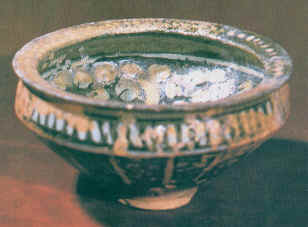
Ceramic-footed cup
Painted under the glaze, 14th century AD
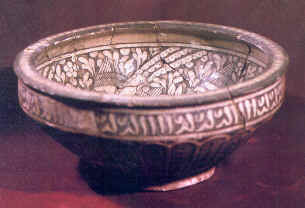
Ceramic-footed bowl
Birds and a repetitive inscription around the rim
Painted under the glaze on gray background
14th century AD
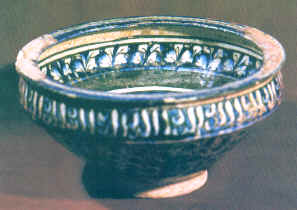
Ceramic cup with patterns in relief
Inside: A row of white flowers on indigo background
Outside: repetitive inscriptions
Painted under the glaze
14th century AD
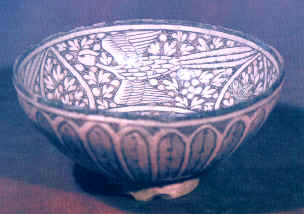
Ceramic-footed bowl
Birds with stretching wings
Soltan-abad, 14th century AD
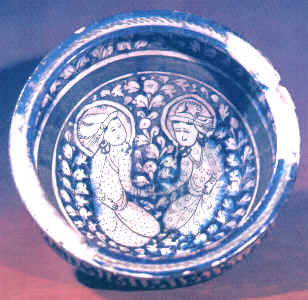
Ceramic cup with patterns in relief
A human figure with a halo surrounded by flower wreaths on indigo background
Painted under the glaze, 14th century AD
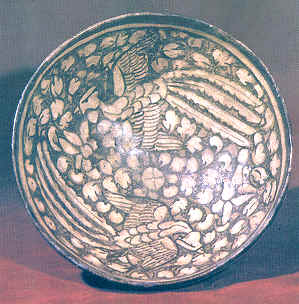
Ceramic bowl with patterns in relief
Birds on gray background, Painted under the glaze
14th century AD
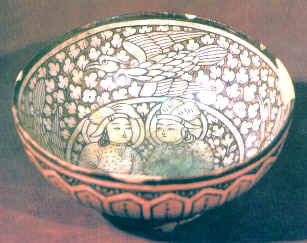
Ceramic bowl
Inside: A central human figure and flying birds
Outside: Vertical striations
Painted under the glaze, 14th century AD
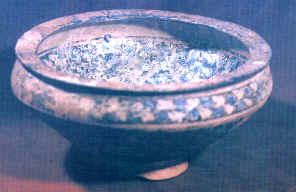
Ceramic cup
Repetitive rows of white flowers on indigo background
Painted under the glaze, 14th century AD
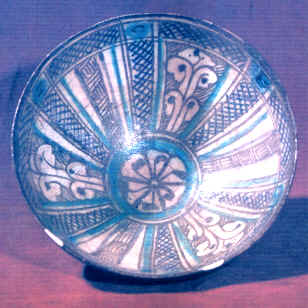
Ceramic-footed bowl
Inside: radiating indigo and turquoise-colored vegetal patterns on white background
Repetitive radial patterns, Early 13th-late 14th century AD
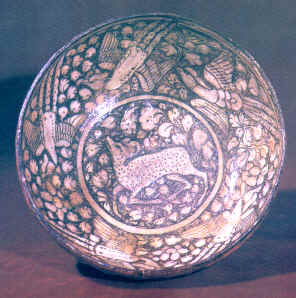
Ceramic bowl
A central antelope surrounded by flying birds, in relief on grayish indigo background
Painted under the glaze, 14th century AD

Ceramic Plate with patterns in relief
Inside: A running antelope, Painted under the glaze
14th century AD
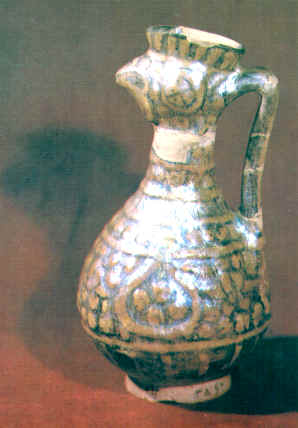
Ceramic pitcher with handle and rooster-head-shaped spot
White patterns in relief on indigo and gray background
Painted under the glaze, Early 13th-late 14th century Ad
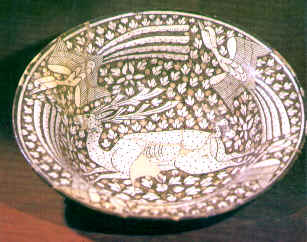
Ceramic plate with patterns in relief
Inside: A running antelope surrounded by birds
Painted under the glaze, 14th century AD
|
|













